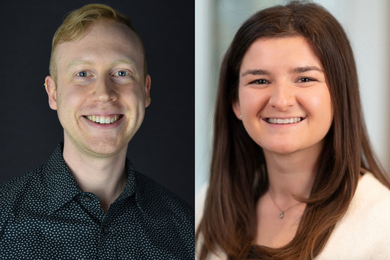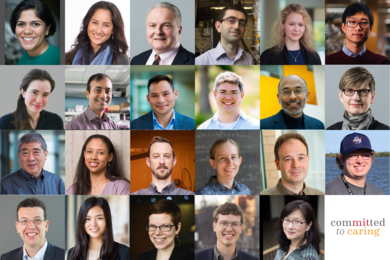He has been a presence at MIT Commencement since 1983. During that period, virtually every diploma awarded has carried his imprint, including the 2,575 to be distributed Friday by President Charles M. Vest and Provost Robert A. Brown.
Yet he hasn't ever attended an MIT Commencement.
"The scribe traditionally remains anonymous," explained calligrapher Thomas Costello, who also did not attend his own graduation ceremonies at the University of Massachusetts at Amherst in 1971.
MIT undergraduates and master's degree recipients are handed a diploma with the name and, if applicable, minor field inscribed by hand (the major is preprinted), while doctorate recipients have the thesis title, however lengthy it may be. To accomplish this, Mr. Costello works 16-hour days during the spring in his Brookline apartment and shares the work with two or three other calligraphers as the deadline looms. MIT is the only institution of higher learning for which Mr. Costello does diplomas.
"I like the idea of doing original work for one worthy recipient who has earned it," he said. "I like the thought that my work is on a piece of paper that will be treasured for the rest of the person's life."
Mr. Costello inscribes the student's name in gothicized Italic, a cross between the blackletter of the late Middle Ages and Chancery Italic, which developed during the Renaissance. "The blackletter style imparts formality and the Chancery a certain grace," said Mr. Costello. "The hand is not widely used and my particular version is unique to MIT." The minors and thesis titles are in compressed foundational style, which has a modern, easy-to-read quality although it is based on a 10th-century miniscule (lower-case letter).
Using a steel-nibbed, chisel-edged tool for consistency and special lightfast ink (a brand coincidentally called Dr. Martin's TECH Waterproof Drawing Ink), he inscribes about 3,500 diplomas. Some are discarded -- thesis titles change, students don't graduate, "and hard as it may be to believe, I make mistakes," said Mr. Costello, 50, who uses turkey and goose quills when working on calf or sheepskin. "I'm getting older, and the hours are getting longer."
The diplomas, printed on Crane's Cover Ivory Wove 901 paper, are printed in an unnamed typeface cut in the early 1900s. They cost about $5 apiece. Mr. Costello receives $2.50 for each name and minor field and $3 for thesis titles, which are longer and more time-consuming.
Mr. Costello, who studied English in college, became a calligrapher by accident. He taught at the Boardman School in Roxbury from 1971-72 before spending five years as an insurance claims specialist. When the company went out of business, his wife noted his interest in calligraphy and suggested that he try to make it a career. He took several courses, including one with Donald Jackson, scribe to Queen Elizabeth of England.
He spends summers inscribing honorary degree citations for Boston University and Emerson College. Among other recent projects, he created a Quaker wedding certificate with illuminated initials in 24K raised gold on a floral background and worked with a bookbinder on a memorial book for Boston College.
"MIT is special," said Mr. Costello, who was a supporting scribe on the MIT diplomas for a year before becoming the primary calligrapher. "It's in the forefront of technology and yet remains humanistic and traditional. I like to think my work preserves that. I'm proud to do it."
MIT thinks Mr. Costello is special.
"He does exquisite work," said Registrar Mary Callahan. "My office takes great pride in the fact that the diploma is beautifully done, accurate and in the hands of the happy graduate at the actual Commencement ceremony."
Although he doesn't attend Commencement, Mr. Costello has visited Killian Court several times. "I enjoy the flowers," he said.
A version of this article appeared in MIT Tech Talk on May 31, 2000.






